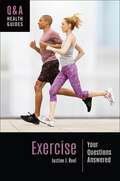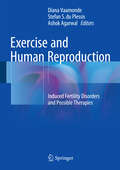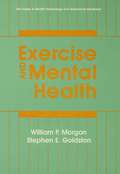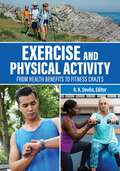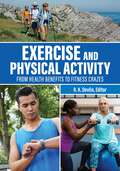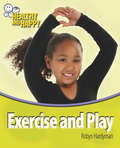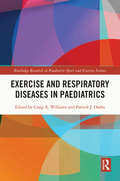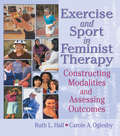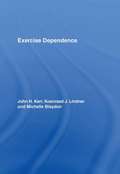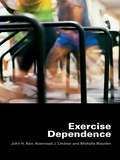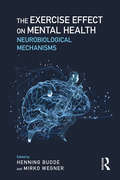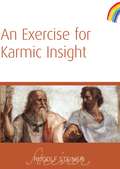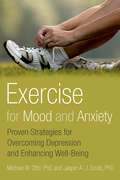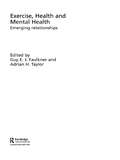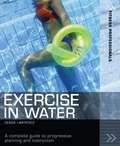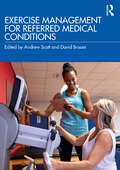- Table View
- List View
Exercise: Your Questions Answered (Q&A Health Guides)
by Justine J. ReelThis book answers readers' most pressing questions about exercise and physical activity and will serve as a valuable resource to anyone interested in starting and maintaining healthy habits in this important area of health.Whether it's going for a run or to a yoga class, playing basketball with friends, or spending an afternoon doing yardwork, moving our bodies regularly is vital for both our physical and mental well-being. This book explores the different forms of exercise and physical activity, their benefits and risks, why so many people find it difficult to be physically active, and how to create and maintain a healthy, sustainable plan for physical activity.Books in Greenwood's Q&A Health Guides series follow a reader-friendly question-and-answer format that anticipates readers' needs and concerns. Prevalent myths and misconceptions are identified and dispelled, and a collection of case studies illustrates key concepts and issues through relatable stories and insightful recommendations. Each book also includes a section on health literacy, equipping teens and young adults with practical tools and strategies for finding, evaluating, and using credible sources of health information both on and off the internet—important skills that contribute to a lifetime of healthy decision-making.
Exercise: Your Questions Answered (Q&A Health Guides)
by Justine J. ReelThis book answers readers' most pressing questions about exercise and physical activity and will serve as a valuable resource to anyone interested in starting and maintaining healthy habits in this important area of health.Whether it's going for a run or to a yoga class, playing basketball with friends, or spending an afternoon doing yardwork, moving our bodies regularly is vital for both our physical and mental well-being. This book explores the different forms of exercise and physical activity, their benefits and risks, why so many people find it difficult to be physically active, and how to create and maintain a healthy, sustainable plan for physical activity.Books in Greenwood's Q&A Health Guides series follow a reader-friendly question-and-answer format that anticipates readers' needs and concerns. Prevalent myths and misconceptions are identified and dispelled, and a collection of case studies illustrates key concepts and issues through relatable stories and insightful recommendations. Each book also includes a section on health literacy, equipping teens and young adults with practical tools and strategies for finding, evaluating, and using credible sources of health information both on and off the internet—important skills that contribute to a lifetime of healthy decision-making.
Exercise and Human Reproduction: Induced Fertility Disorders and Possible Therapies
by Diana Vaamonde Stefan S du Plessis Ashok AgarwalProviding a comprehensive review of the interactions between exercise and human reproduction, this unique text focuses on both the positive and negative consequences of sport and physical activity on male and female fertility and infertility and the biological mechanisms and processes behind them. Beginning with a review of the structure and function of the male and female reproductive systems as well as fertilization and gestation, the discussion then turns to the physiology and endocrinology of sport and exercise, which is further elaborated in subsequent chapters on the impact of physical activity, hormonal changes, pathologies, and consequences of drug use for active men and women. Additional chapters address related topics, such as the impact of sport on young athletes and developing reproductive potential, physical activity and pregnancy, the use of oral contraceptives in athletes, oxidative stress, and the impact of nutritional deficiencies on athletes’ fertility, with a final chapter providing recommendations and therapeutic guidelines for exercise-related reproductive disorders. Covering everything from the fundamental principles of sports physiology and human reproductive potential to the interaction between physical exercise and the endocrinology of the reproductive system, Exercise and Human Reproduction is an authoritative resource for helping clinicians understand how the reproductive system adapts to activity and exercise and offers strategies to avoid potential harm to human reproduction.
Exercise And Mental Health (Series in Health Psychology and Behavioral Medicine)
by William P. Morgan Stephen E. GoldstonPublished in the year 1987, Exercise and Mental Health is a valuable contribution to the field of Counseling and School Pscyhology.
Exercise And Mental Health (Series in Health Psychology and Behavioral Medicine)
by William P. Morgan Stephen E. GoldstonPublished in the year 1987, Exercise and Mental Health is a valuable contribution to the field of Counseling and School Pscyhology.
Exercise and Physical Activity: From Health Benefits to Fitness Crazes
by R. K. DevlinThis encyclopedia explores exercise and physical activity from a variety of angles, including anatomy and exercise science, health benefits and risks, the wide array of sports and recreational activities available, and the sociocultural context of physical fitness.Exercise and Physical Activity: From Health Benefits to Fitness Crazes is a one-volume encyclopedia featuring more than 200 entries that cover a multitude of exercise-related topics. Content is divided across five broad themes: anatomy, exercise science, sports and activities, health benefits and risks, and exercise and society.The anatomy theme includes entries on all the major skeletal muscle groups and associated connective tissues. Within the exercise science theme, entries focus on topics within the fields of physiology, kinesiology, and sports psychology. Profiles of more than 70 sports and recreational activities are included. Entries under the theme of health benefits and risks explore the effects of exercise on many of the body's physiological processes and related systems, as well as specific sports-related injuries. Exercise and society entries profile influential individuals and organizations, as well as fitness trends. Together, these themes support a holistic understanding of exercise, encompassing both the theoretical and the practical.
Exercise and Physical Activity: From Health Benefits to Fitness Crazes
by R. K. DevlinThis encyclopedia explores exercise and physical activity from a variety of angles, including anatomy and exercise science, health benefits and risks, the wide array of sports and recreational activities available, and the sociocultural context of physical fitness.Exercise and Physical Activity: From Health Benefits to Fitness Crazes is a one-volume encyclopedia featuring more than 200 entries that cover a multitude of exercise-related topics. Content is divided across five broad themes: anatomy, exercise science, sports and activities, health benefits and risks, and exercise and society.The anatomy theme includes entries on all the major skeletal muscle groups and associated connective tissues. Within the exercise science theme, entries focus on topics within the fields of physiology, kinesiology, and sports psychology. Profiles of more than 70 sports and recreational activities are included. Entries under the theme of health benefits and risks explore the effects of exercise on many of the body's physiological processes and related systems, as well as specific sports-related injuries. Exercise and society entries profile influential individuals and organizations, as well as fitness trends. Together, these themes support a holistic understanding of exercise, encompassing both the theoretical and the practical.
Exercise and Play: Exercise And Play (Healthy and Happy #1)
by Robyn HardymanFind out all about how to stay healthy and happy with fun exercise and games! This book explores the many kinds of exercise and sport you can do, and gives you Healthy Hints - tips on great activities you can enjoy.
Exercise and Respiratory Diseases in Paediatrics (Routledge Research in Paediatric Sport and Exercise Science)
by Craig A. WilliamsIt is commonly accepted that "exercise is good for children" but, considering the number of children worldwide exercising, we know comparatively little, compared to adults, about how specific mechanisms influence health and sports performance. There are considerable obstacles that challenge the progress of paediatric research, not least in relation to ethical and methodological considerations. Therefore, advances in the science and clinical application of paediatric exercise physiology, psychology and biomechanics have not reached their potential. Paediatric clinical exercise physiology has application to the role of exercise in the assessment and treatment of paediatric chronic diseases, the utilization of physical activity in preventing illness and enhancing wellbeing and can enhance our understanding of how sports can be made safer and more enjoyable for our young athletes. Exercise and Respiratory Diseases in Paediatrics highlights research by various methodologies, including literature reviews, experimental research and innovations, applied to children and adolescents with respiratory diseases. Chronic conditions such as asthma, bronchiectasis (e.g., cystic fibrosis), and those associated with prematurity and medical complexity are worldwide health problems for young people and although management includes pharmaceutical medications, physiotherapy, nutritional and psychological support, exercise has a role in optimising multidisciplinary care. There has been unprecedented acceleration in new technologies and methodologies that promise to facilitate paediatric research and these are explained and discussed as future research directions. This is reading for post graduate students, researchers, academics and policy makers within the field of paediatric healthcare, physical activity, physiology and the related disciplines.
Exercise and Respiratory Diseases in Paediatrics (Routledge Research in Paediatric Sport and Exercise Science)
by Craig A. Williams Patrick J. OadesIt is commonly accepted that "exercise is good for children" but, considering the number of children worldwide exercising, we know comparatively little, compared to adults, about how specific mechanisms influence health and sports performance. There are considerable obstacles that challenge the progress of paediatric research, not least in relation to ethical and methodological considerations. Therefore, advances in the science and clinical application of paediatric exercise physiology, psychology and biomechanics have not reached their potential. Paediatric clinical exercise physiology has application to the role of exercise in the assessment and treatment of paediatric chronic diseases, the utilization of physical activity in preventing illness and enhancing wellbeing and can enhance our understanding of how sports can be made safer and more enjoyable for our young athletes. Exercise and Respiratory Diseases in Paediatrics highlights research by various methodologies, including literature reviews, experimental research and innovations, applied to children and adolescents with respiratory diseases. Chronic conditions such as asthma, bronchiectasis (e.g., cystic fibrosis), and those associated with prematurity and medical complexity are worldwide health problems for young people and although management includes pharmaceutical medications, physiotherapy, nutritional and psychological support, exercise has a role in optimising multidisciplinary care. There has been unprecedented acceleration in new technologies and methodologies that promise to facilitate paediatric research and these are explained and discussed as future research directions. This is reading for post graduate students, researchers, academics and policy makers within the field of paediatric healthcare, physical activity, physiology and the related disciplines.
Exercise and Sport in Feminist Therapy: Constructing Modalities and Assessing Outcomes
by Ruth Hall Carole OglesbyIntegrate physical activity into feminist therapy!This book explores the healing use of exercise and sport as a helpful adjunct to therapy from several therapeutic orientations within the feminist context. It looks at the ways that feminist orientations challenge the mind-body dichotomy and explores the benefits of integrating physical activity, exercise, and sport into therapy. From the editors: "The contributors to this book display a diversity of theory and research approaches, including the integration of the exercise/sport sciences and exercise physiology. This volume is unique in that there has been comparatively little written about the use of exercise in therapy even though exercise is a wonderful and useful intervention tool in the treatment of depression, stress, anxiety disorders, and chronic pain. This book illustrates how exercise can be applied to inpatient and outpatient populations, to the neurotic, and to the chronically mentally ill. Exercise can reduce the incidence of chronic diseases, including diabetes and hypertension, as well as address physical problems such as obesity. Exercise can give one a sense of mastery and self-confidence. As our authors suggest, exercise must be tailored to specific issues and client populations and diagnoses, level of functioning, age, overall health, and cultural context must all be taken into account."Exercise and Sport in Feminist Therapy: Constructing Modalities and Assessing Outcomes examines: the theory supporting the use of physicality to enhance various types of psychotherapy-psychoanalytic, cognitive-behavioral, constructivist, narrative, and organismic/systems practical methods of integrating exercise into varied orientations an exercise program for women with fibromyalgia a way to use exercise to enhance rehabilitation from breast cancer the use of exercise in group therapy for women suffering with chronic mental illness the “tend and befriend” model, which can help clients to meet their exercise program responsibilities
Exercise and Sport in Feminist Therapy: Constructing Modalities and Assessing Outcomes
by Ruth Hall Carole OglesbyIntegrate physical activity into feminist therapy!This book explores the healing use of exercise and sport as a helpful adjunct to therapy from several therapeutic orientations within the feminist context. It looks at the ways that feminist orientations challenge the mind-body dichotomy and explores the benefits of integrating physical activity, exercise, and sport into therapy. From the editors: "The contributors to this book display a diversity of theory and research approaches, including the integration of the exercise/sport sciences and exercise physiology. This volume is unique in that there has been comparatively little written about the use of exercise in therapy even though exercise is a wonderful and useful intervention tool in the treatment of depression, stress, anxiety disorders, and chronic pain. This book illustrates how exercise can be applied to inpatient and outpatient populations, to the neurotic, and to the chronically mentally ill. Exercise can reduce the incidence of chronic diseases, including diabetes and hypertension, as well as address physical problems such as obesity. Exercise can give one a sense of mastery and self-confidence. As our authors suggest, exercise must be tailored to specific issues and client populations and diagnoses, level of functioning, age, overall health, and cultural context must all be taken into account."Exercise and Sport in Feminist Therapy: Constructing Modalities and Assessing Outcomes examines: the theory supporting the use of physicality to enhance various types of psychotherapy-psychoanalytic, cognitive-behavioral, constructivist, narrative, and organismic/systems practical methods of integrating exercise into varied orientations an exercise program for women with fibromyalgia a way to use exercise to enhance rehabilitation from breast cancer the use of exercise in group therapy for women suffering with chronic mental illness the “tend and befriend” model, which can help clients to meet their exercise program responsibilities
Exercise Dependence
by John H. Kerr Michelle Blaydon Koenraad J. LindnerExercise dependence or addiction has been described as a 'positive addiction', but it can have links with damaging dysfunctional and excessive behaviours, including eating disorders. Clinical and sport psychologists now acknowledge the condition and report that it can be found in recreational exercisers and competitive athletes. This is the first text to provide a comprehensive guide to exercise dependence. The text contains case studies and reviews research into exercise dependence in both 'exercise' and 'sports' contexts. The authors examine the condition in the widest sense, exploring different types of exercise dependence, risk factors associated with the condition, the experiences and motivational characteristics of sufferers, links with eating disorders, and a number of approaches to counselling. This text will be of significant interest to psychologists working in sport, health and clinical practice, as well as to athletes and sports coaches, particularly those involved in endurance sports associated with higher incidences of exercise dependence. 9780415393454 9780203946794
Exercise Dependence
by John H. Kerr Koenraad J. Lindner Michelle BlaydonExercise dependence or addiction has been described as a 'positive addiction', but it can have links with damaging dysfunctional and excessive behaviours, including eating disorders. Clinical and sport psychologists now acknowledge the condition and report that it can be found in recreational exercisers and competitive athletes. This is the first text to provide a comprehensive guide to exercise dependence. The text contains case studies and reviews research into exercise dependence in both 'exercise' and 'sports' contexts. The authors examine the condition in the widest sense, exploring different types of exercise dependence, risk factors associated with the condition, the experiences and motivational characteristics of sufferers, links with eating disorders, and a number of approaches to counselling. This text will be of significant interest to psychologists working in sport, health and clinical practice, as well as to athletes and sports coaches, particularly those involved in endurance sports associated with higher incidences of exercise dependence.
Exercise Dependence
by John H. Kerr Koenraad J. Lindner Michelle BlaydonExercise dependence or addiction has been described as a 'positive addiction', but it can have links with damaging dysfunctional and excessive behaviours, including eating disorders. Clinical and sport psychologists now acknowledge the condition and report that it can be found in recreational exercisers and competitive athletes. This is the first text to provide a comprehensive guide to exercise dependence. The text contains case studies and reviews research into exercise dependence in both 'exercise' and 'sports' contexts. The authors examine the condition in the widest sense, exploring different types of exercise dependence, risk factors associated with the condition, the experiences and motivational characteristics of sufferers, links with eating disorders, and a number of approaches to counselling. This text will be of significant interest to psychologists working in sport, health and clinical practice, as well as to athletes and sports coaches, particularly those involved in endurance sports associated with higher incidences of exercise dependence.
Exercise Dependence (PDF)
by John H. Kerr Michelle Blaydon Koenraad J. LindnerExercise dependence or addiction has been described as a 'positive addiction', but it can have links with damaging dysfunctional and excessive behaviours, including eating disorders. Clinical and sport psychologists now acknowledge the condition and report that it can be found in recreational exercisers and competitive athletes. This is the first text to provide a comprehensive guide to exercise dependence. The text contains case studies and reviews research into exercise dependence in both 'exercise' and 'sports' contexts. The authors examine the condition in the widest sense, exploring different types of exercise dependence, risk factors associated with the condition, the experiences and motivational characteristics of sufferers, links with eating disorders, and a number of approaches to counselling. This text will be of significant interest to psychologists working in sport, health and clinical practice, as well as to athletes and sports coaches, particularly those involved in endurance sports associated with higher incidences of exercise dependence. 9780415393454 / 9780203946794
The Exercise Effect on Mental Health: Neurobiological Mechanisms
by Henning Budde Mirko WegnerThe Exercise Effect on Mental Health contains the most recent and thorough overview of the links between exercise and mental health, and the underlying mechanisms of the brain. The text will enhance interested clinicians’ and researchers’ understanding of the neurobiological effect of exercise on mental health. Editors Budde and Wegner have compiled a comprehensive review of the ways in which physical activity impacts the neurobiological mechanisms of the most common psychological and psychiatric disorders, including depression, anxiety, bipolar disorder, and schizophrenia. This text presents a rigorously evidence-based case for exercise as an inexpensive, time-saving, and highly effective treatment for those suffering from mental illness and distress.
The Exercise Effect on Mental Health: Neurobiological Mechanisms
by Henning Budde Mirko WegnerThe Exercise Effect on Mental Health contains the most recent and thorough overview of the links between exercise and mental health, and the underlying mechanisms of the brain. The text will enhance interested clinicians’ and researchers’ understanding of the neurobiological effect of exercise on mental health. Editors Budde and Wegner have compiled a comprehensive review of the ways in which physical activity impacts the neurobiological mechanisms of the most common psychological and psychiatric disorders, including depression, anxiety, bipolar disorder, and schizophrenia. This text presents a rigorously evidence-based case for exercise as an inexpensive, time-saving, and highly effective treatment for those suffering from mental illness and distress.
An Exercise for Karmic Insight
by Rudolf SteinerThere is the possibility of a comparatively quick maturing of insight into karmic relationships if, for a considerable time, we try patiently, and with inner energy, to picture with greater and greater consciousness an experience which would otherwise simply take its course, without being properly grasped, and fade away in the course of life...In this unique lecture, Rudolf Steiner presents a practical exercise for gaining insight into karma. He draws our attention to the ordinary events of life, encouraging us to take an image of a single event and meditate on it. He describes the method in great detail, and explains how, over several days and nights, the image becomes incorporated into our various spiritual bodies. Eventually, this image reaches our physical body in a transformed state, leading to a perception of a previous earth life and the cause of the event first pictured in meditation...
Exercise for Mood and Anxiety: Proven Strategies for Overcoming Depression and Enhancing Well-Being
by Michael Otto Jasper A.J. SmitsExercise has long been touted anecdotally as an effective tool for mood improvement, but only recently has rigorous science caught up with these claims. There is now overwhelming evidence that regular exercise can help relieve low mood-from feelings of stress and anxiety to full depressive episodes. With Exercise for Mood and Anxiety, Michael Otto and Jasper Smits, well-known authorities on cognitive behavioral therapy, take their empirically-based mood regulation strategy from the clinic to the general public. Written for those with diagnosed mood disorders as well as those who simply need a new strategy for managing the low mood and stress that is an everyday part of life, this book provides readers with step-by-step guidance on how to start and maintain an exercise program geared towards improving mood, with a particular emphasis on understanding the relationship between mood and motivation. Readers learn to attend carefully to mood states prior to and following physical activity in order to leverage the full benefits of exercise, and that the trick to maintaining an exercise program is not in applying more effort, but in arranging one's environment so that less effort is needed. As a result readers not only acquire effective strategies for adopting a successful program, but are introduced to a broader philosophy for enhancing overall well-being. Providing patient vignettes, rich examples, and extensive step-by-step guidance on overcoming the obstacles that prevent adoption of regular exercise for mood, Exercise for Mood and Anxiety is a unique translation of scientific principles of clinical and social psychology into an action-based strategy for mood change.
Exercise for Mood and Anxiety: Proven Strategies for Overcoming Depression and Enhancing Well-Being
by Michael Otto Jasper A.J. SmitsExercise has long been touted anecdotally as an effective tool for mood improvement, but only recently has rigorous science caught up with these claims. There is now overwhelming evidence that regular exercise can help relieve low mood-from feelings of stress and anxiety to full depressive episodes. With Exercise for Mood and Anxiety, Michael Otto and Jasper Smits, well-known authorities on cognitive behavioral therapy, take their empirically-based mood regulation strategy from the clinic to the general public. Written for those with diagnosed mood disorders as well as those who simply need a new strategy for managing the low mood and stress that is an everyday part of life, this book provides readers with step-by-step guidance on how to start and maintain an exercise program geared towards improving mood, with a particular emphasis on understanding the relationship between mood and motivation. Readers learn to attend carefully to mood states prior to and following physical activity in order to leverage the full benefits of exercise, and that the trick to maintaining an exercise program is not in applying more effort, but in arranging one's environment so that less effort is needed. As a result readers not only acquire effective strategies for adopting a successful program, but are introduced to a broader philosophy for enhancing overall well-being. Providing patient vignettes, rich examples, and extensive step-by-step guidance on overcoming the obstacles that prevent adoption of regular exercise for mood, Exercise for Mood and Anxiety is a unique translation of scientific principles of clinical and social psychology into an action-based strategy for mood change.
Exercise, Health and Mental Health: Emerging Relationships
by Guy E.J. Faulkner Adrian H. TaylorExercise, Health and Mental Health provides an introduction to this emerging field and a platform for future research and practice. Written by internationally acclaimed exercise, health and medical scientists, it is the first systematic review of the evidence for the potential role of exercise in: treating and managing mental health problems including dementia, schizophrenia, drug and alcohol dependence coping with chronic clinical conditions including cancer, heart disease and HIV/AIDS enhancing well-being in the general population – by improving sleep, assisting in smoking cessation, and as a way of addressing broader social issues such as anti-social behaviour. Adopting a consistent and accessible format, the research findings for each topic are clearly summarized and critically examined for their implications.
Exercise, Health and Mental Health: Emerging Relationships
by Guy E.J. Faulkner Adrian H. TaylorExercise, Health and Mental Health provides an introduction to this emerging field and a platform for future research and practice. Written by internationally acclaimed exercise, health and medical scientists, it is the first systematic review of the evidence for the potential role of exercise in: treating and managing mental health problems including dementia, schizophrenia, drug and alcohol dependence coping with chronic clinical conditions including cancer, heart disease and HIV/AIDS enhancing well-being in the general population – by improving sleep, assisting in smoking cessation, and as a way of addressing broader social issues such as anti-social behaviour. Adopting a consistent and accessible format, the research findings for each topic are clearly summarized and critically examined for their implications.
Exercise in Water: A complete guide to progressive planning and instruction (Fitness Professionals)
by Debbie LawrenceFitness Professionals: Exercise in Water (3rd edition) is a practical handbook for theregular exerciser who wishes to know more about the enormous benefitsof training in water, and the fitness professional who seeks a thoroughgrounding in Level 2 and 3 knowledge.This new edition will completely update the book, taking into accountlatest best practice and explicitly linking the contents to thenational standards to which all gym instructors and personal trainersare assessed. Exercise in Water is one of the core modules of the Level 2 gyminstructors syllabus, and a new Level 3 qualification has been added inJanuary 2008. This edition will cover all this knowledge, usingrevision notes and tests as useful tools for the readers' study.Fitness Professionals: Exercise in Water therefore aims to become thereference on this discipline for everyone involved in the health andfitness industry.
Exercise Management for Referred Medical Conditions
by Andrew Scott David BroomExercise referral describes the process of consultation, planning and instructing physical activity programmes and applying appropriate behaviour change strategies for clients presenting a range of low- to medium-risk medical conditions. Exercise Management for Referred Medical Conditions is the first book to integrate exercise prescription with the development of healthy behaviours and the promotion of physical activity and well-being and provides students with an evidence-based, applied guide to becoming effective exercise referral practitioners. The book draws upon the latest research and recommends best practices for creating referral pathways, providing exercise programmes and engaging clients in health lifestyles. Covering the pathology, medical management, role of exercise and recommendations for programming in each case, it discusses a range of conditions, including: Obesity and type I and II diabetes Hypertension and dyslipidaemia Asthma Low back pain, osteoarthritis and joint replacement, rheumatoid arthritis, and osteoporosis Depression, anxiety and stress disorders Consistently organised and laden with pedagogical features, including learning objectives, key terms, case studies, future developments and chapter summaries, no other book offers such a clear, holistic model for exercise referral. This is a vital resource for any student undertaking vocational courses in exercise referral and an important reference for exercise scientists, physical therapists, fitness professionals or local policy-makers interested in the use of physical activity in healthcare.
